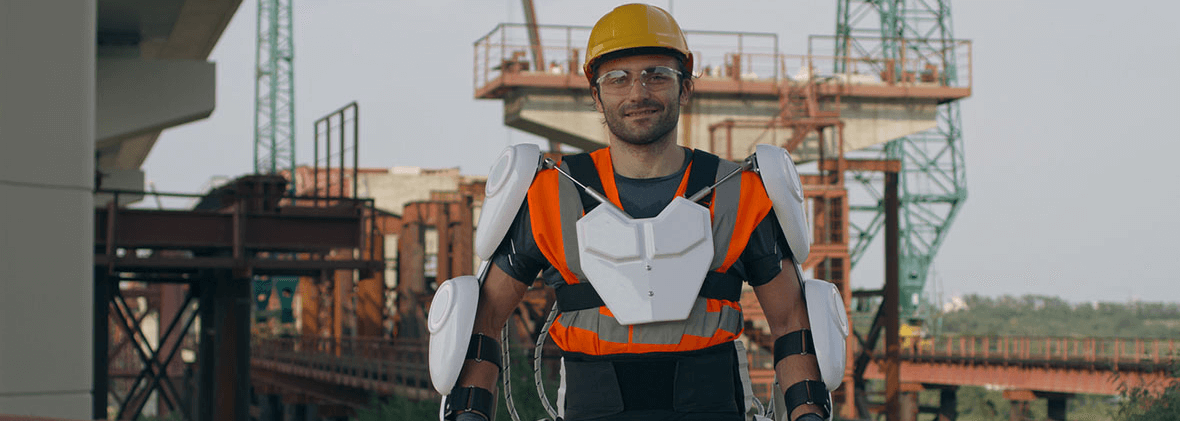
What Is a Construction Exoskeleton?
A construction exoskeleton, also known as an exosuit, is a wearable device of metal frames fitted with motorized “muscles” to help construction workers perform physically demanding tasks. The construction industry is embracing exoskeletons to improve worker safety, productivity and efficiency.
These futuristic machines can perform various tasks ranging from lifting heavy equipment to providing stability when working at heights, aiming to reduce body strain from repetitive tasks throughout the workday. To achieve this, exoskeletons offer additional support to a worker's back, legs or hands and any areas most affected by prolonged strain.
Discover the numerous types of construction exoskeletons and how they can improve safety and productivity for your operations.
Jump to a section:
What Is an Exoskeleton Used for in Construction?
In the construction industry, exoskeletons are used for various applications to enhance worker safety, productivity and well-being. When you use this equipment at your site, the devices can provide support, strength and protection for workers by reducing strain and risk of injury. Overall, this crucial technology can provide:
- Arms and shoulder support
- Back support
- Standing and crouching support
Here are 10 types of applications for exoskeletons in the construction industry:
1. Heavy Lifting and Load Handling
Construction work often involves lifting and carrying heavy objects, from equipment to tools. Exosuits can assist workers by providing mechanical support to the upper body and reducing strain on muscles and joints.
Powered exoskeletons can supplement a worker's strength, making lifting and moving heavy loads easier. As a result, you can appreciate improved efficiency in your workplace and a reduced risk of injuries.
2. Overhead Work and Arm Support
Various construction tasks require your employees to work with their arms raised overhead, from installing ceiling panels and electrical wiring to plumbing tasks. Exosuits with arm support structures can reduce fatigue and muscle strain, providing mechanical support to the arms and reducing the effort needed to hold them in an elevated position.
Exoskeletons can improve your workers' comfort and prevent fatigue-related accidents when performing overhead tasks.
3. Working at Heights and Fall Prevention
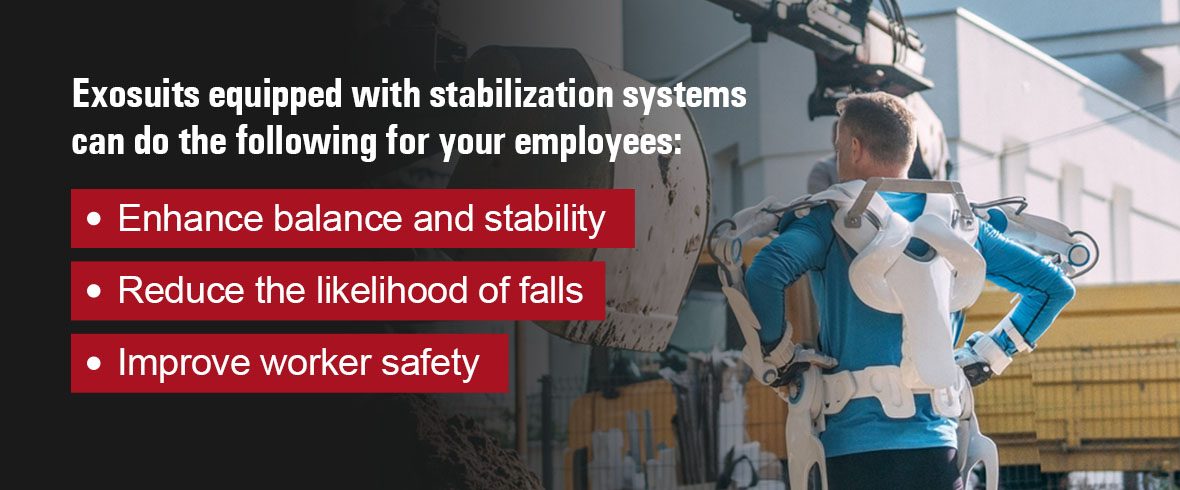
Construction workers face a risk of falls when working at taller heights, such as ladders, scaffolding or rooftops. Exosuits equipped with stabilization systems can do the following for your employees:
- Enhance balance and stability
- Reduce the likelihood of falls
- Improve worker safety
These exoskeletons use sensors and actuators to detect and correct body movements, providing additional support to prevent uncontrolled movements that might lead to accidents.
4. Ergonomic Support and Posture Correction
Exoskeletons can provide support for ergonomic challenges often presented on construction sites. They promote posture, supporting the back, shoulders and knees, reducing strain and risk of injuries caused by repetitive bending, lifting or prolonged standing. As a result, exosuits can promote better body alignment and distribute weight effectively while leading to more comfort, less fatigue and better long-term musculoskeletal health.
5. Rehabilitation and Injury Prevention
Exosuits can also be used for rehabilitation, helping workers recover from injuries and preventing further damage. These machines can offer controlled assistance and resistance, helping employees engage in rehabilitative exercises and gradually regain strength and mobility. By assisting in targeted movements and providing real-time feedback, exoskeletons can support recovery and allow workers to return to their jobs more quickly and safely.
6. Personal Protective Equipment Integration
Exoskeletons can be integrated with personal protective equipment (PPE) to enhance worker safety. For instance, you might invest in exosuits with built-in harness systems, which can provide mechanical support and fall protection — combining the benefits of PPE and exoskeleton technology. The integration can ensure your workers are protected and supported as they perform high-risk tasks in construction environments. Reducing injuries can improve your company's compliance with OSHA standards.
7. Fatigue Reduction and Worker Well-Being
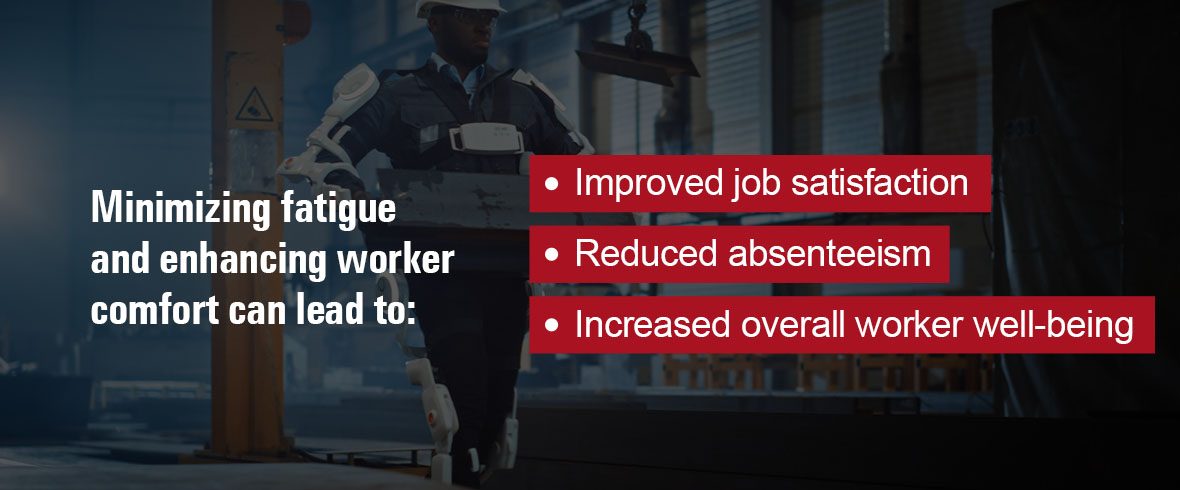
The physically-demanding nature of construction work can lead to worker fatigue, which can affect your team's overall productivity, concentration and well-being. Exoskeletons reduce fatigue by providing physical support, reducing muscle strain and conserving energy during strenuous tasks. Minimizing fatigue and enhancing worker comfort can lead to the following:
- Improved job satisfaction
- Reduced absenteeism
- Increased overall worker well-being
8. Augmented Reality and Work Instructions
Some exosuits incorporate augmented reality (AR) technology to provide workers with real-time instructions, visual aids and data overlays. The integrations offer your workers the following:
- Improved guidance and specifications
- Access to relevant information
- Visualized construction plans
This information can be accessed through the exosuit's visor or heads-up display. The AR-based assistance can enhance worker productivity, accuracy and on-site decision-making.
9. Customization and Adaptability
With exosuits, you can appreciate customization and adaptability for any task. Most are designed with modular components and features that accommodate different body sizes, jobs and work environments. Customization allows employees to get them individually fitted to ensure better comfort and optimal performance. Additionally, some exoskeletons are designed to be lightweight and unobtrusive, allowing your workers to move freely and perform tasks without being hindered by the device.
10. Workforce Aging and Injury Prevention
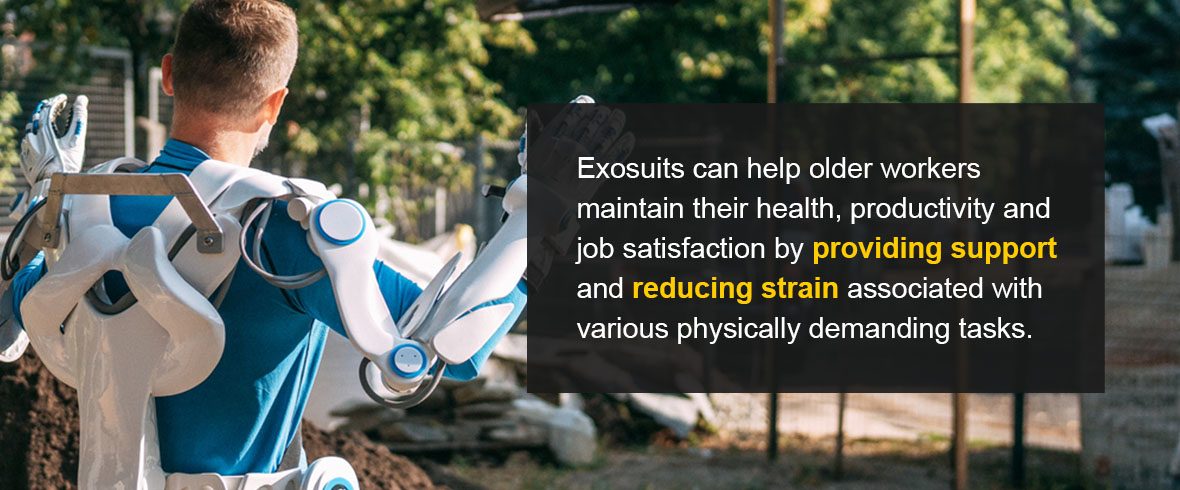
As the construction workforce ages, exoskeletons can play a crucial role in extending careers and preventing injuries. Exosuits can help older workers maintain their health, productivity and job satisfaction by providing support and reducing strain associated with various physically demanding tasks. These devices allow workers to keep contributing to the industry while mitigating the risk of age-related injuries.
What Are the Different Types of Exoskeletons in Construction?
Exoskeletons can come in various types, from purely mechanical machines to operate with a mix of mechanics and electricity. Depending on the suit's function, you'll find frames made from hard materials like metal or soft materials like cloth and textiles.
Mechanical
Mechanical exoskeletons, or passive exoskeletons, rely only on mechanical structures and springs to support and reduce strain on the wearer's body. These exoskeletons don't require external power sources and are often lightweight and easy to use. They offer help with the following tasks:
- Heavy lifting
- Overhead work
- Repetitive motions
Mechanical exosuits can be adjusted to fit different body sizes and worn comfortably over your employees' work attire.
Powered
Powered exoskeletons, also known as robotic or active exoskeletons, use electric motors or hydraulics. These exosuits amplify the user's physical abilities, allowing them to lift heavier loads or perform tasks with less effort. Powered exosuits can be used for:
- Heavy lifting
- Load handling
- Tasks requiring upper body strength
These exosuits can benefit your team if you have demanding tasks involving repetitive movements or prolonged exertion.
Upper Body
Upper-body exosuits focus on assisting the upper body, including the arms, shoulders and back. Upper exosuits can incorporate features like arm supports, back braces and shoulder straps to distribute workers' weight effectively and promote better posture. One study found that arm-support exoskeletons could reduce physical demands on workers' shoulders, neck and back.
They are designed to reduce fatigue during tasks like:
- Overhead work
- Heavy lifting
- Tasks that require extended arm elevation
These suits can be beneficial if your operations include ceiling installation, overhead piping, sprinkler installation, overhead conduit fastening, painting or electrical work.
Full Body
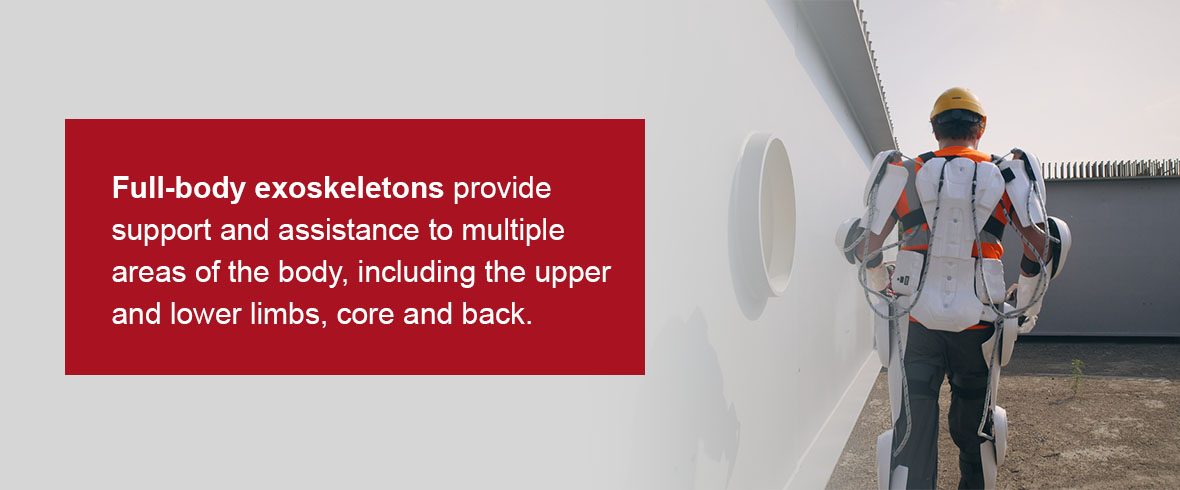
Full-body exoskeletons provide support and assistance to multiple areas of the body, including the upper and lower limbs, core and back. These exosuits are designed to improve construction workers' posture, balance and stability, especially during tasks like:
- Working at heights
- Carrying heavy loads
- Performing physically-demanding movements
Full-body exoskeletons can incorporate harness systems, joint support and stabilization features, making them ideal for tasks that include scaffolding, working on elevated platforms or performing tasks in challenging environments.
Lower Body
Lower body exoskeletons focus on providing stability and support to the legs and lower extremities. They are beneficial for tasks that involve prolonged standing, walking, bending, crouching or repetitive movements.
Your construction workers could benefit from lower-body exosuits for the following tasks:
- Concrete pouring
- Floor installation
- Site inspections
- Drywalling
- Drilling
These exosuits can reduce strain on the lower back, hips and knees to reduce the risk of injury. One study found that this technology could reduce the force on the spine to alleviate lower back pain.
Smart
Smart exosuits incorporate advanced sensors, actuators and algorithms to provide real-time feedback and adaptive support to the wearer. These exoskeletons can monitor the user's movements and detect fatigue before adjusting assistance accordingly.
Smart exoskeletons can optimize the intensity of support and timing, providing:
- Energy efficiency
- Reduced risk of overexertion
- Collected data on worker performance, ergonomics and safety
Overall, smart exoskeletons can allow for analysis and optimization of your operation's work processes.
Rehabilitation
While exoskeletons can improve the human body's ability, studies show they also offer healing treatment for those with lower extremity dysfunction.
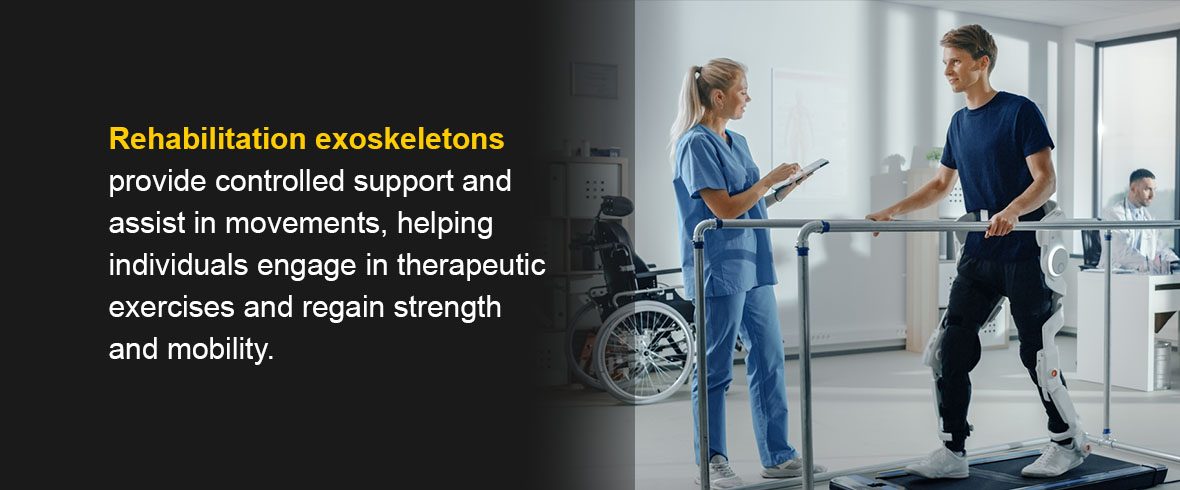
Rehabilitation exosuits are specifically designed to support the recovery and rehabilitation of injured construction workers. These exoskeletons provide controlled support and assist in movements, helping individuals engage in therapeutic exercises and regain strength and mobility.
These suits can be used for post-injury rehabilitation, physical therapy and to assist in your workers' safe return to work. They offer personalized assistance and can be adjusted to provide the right level of support for their needs.
Collaborative
Collaborative exoskeletons, or industrial exoskeletons, are designed to work with the user's natural movements. These exosuits are lightweight, allowing workers to maintain agility and flexibility. Your employees can appreciate these suits for tasks that require dexterity, precision and fine motor skills, such as assembling small parts. They can enhance productivity while minimizing fatigue and the risk of strain.
Hybrid
Hybrid exoskeletons combine passive and powered elements, blending mechanical support with robotic assistance. These exosuits offer benefits of both mechanical and powered systems and can allow enhanced strength and performance for physically demanding tasks. Hybrid exoskeletons can be customized to address specific tasks and requirements, making them adaptable to changing work environments and conditions.
Customized
Customized exosuits can be made to meet your individual employees' specific needs and body dimensions. You can tailor each suit to provide optimal support, comfort and functionality. Customization can include:
- Adjusting joint angles
- Modifying attachment points
- Integrating the exoskeleton with PPE
Investing in customized exosuits ensures a more precise fit while getting the most benefits of its technology. These suits can also cater to the unique requirements of your different work environments and workers.
Types of Exoskeleton Products
Exoskeletons come in various types and configurations, each designed for a specific need and application. These innovative devices can provide you with support, assistance and protection in numerous industries. Here are just a few types of exoskeleton products:
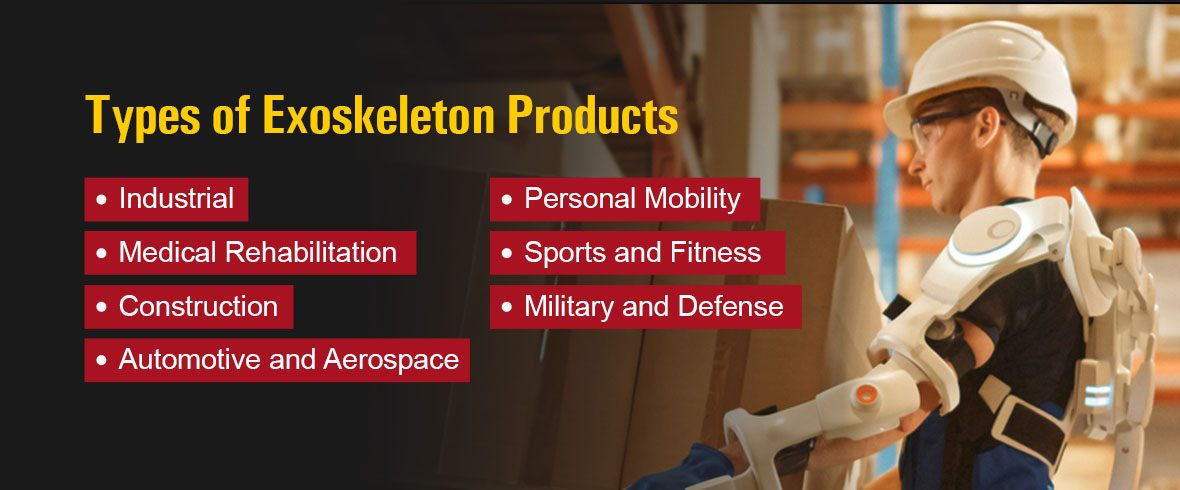
Industrial
Industrial exoskeletons are designed to help workers in sectors like logistics, manufacturing and warehousing. These exosuits can help workers with ergonomic support and assistance in lifting heavy objects. Overall, this technology can reduce the risk of injuries and improve worker comfort and productivity.
Medical Rehabilitation
Medical rehabilitation exoskeletons are used in health care settings to help individuals recover from mobility impairments. These exosuits can provide assistive movements, helping people with conditions like spinal cord injuries or stroke to regain mobility. Rehabilitation exoskeletons can assist with walking, standing and improving upper body functions, allowing workers to return to tasks without sacrificing safety or comfort.
Construction
As mentioned, construction exoskeletons are used in the construction industry to help workers with physically demanding tasks, improving worker safety and reducing strain on the job from lifting heavy objects or performing overhead work. Depending on your task, you can get them in upper, lower and full-body suits.
Automotive and Aerospace
Automotive and aerospace exoskeletons are used in industries with repetitive or overhead tasks. These exosuits can reduce fatigue and strain on workers' bodies, improving ergonomics and preventing injuries. They are designed to assist with tasks like:
- Vehicle assembly
- Overhead repairs
- Working in tight spaces
Personal Mobility
Personal mobility exosuits can enhance the movement and independence of people with walking difficulties. These exoskeletons provide powered assistance to help people with conditions like:
- Spinal cord injuries
- Lower limb weakness
- Neurological disorders
This technology can help these individuals walk with improved stability and reduced effort. By supporting their legs and providing controlled movements, personal mobility exoskeletons can help the wearer regain mobility and engage in daily activities.
These exosuits can transform the lives of people with mobility impairments, allowing them more freedom, autonomy and improved quality of life.
Sports and Fitness
Sports and fitness exoskeletons can improve a person's athletic performance by assisting in rehabilitation and preventing sports or fitness injuries. The technology can provide the following:
- Support and stability
- Targeted resistance for specific movements
- Optimized training
- Improved technique
- Increased physical limits
- Improved running or jumping capabilities
Sports and fitness exoskeletons can help athletes maximize their potential, prevent injuries and help recover after sports-related injuries. Integrating technology and human movements allow this crucial technology to revolutionize how individuals train, perform and excel in fitness.
Military and Defense
These exoskeletons can enhance performance and endurance. They assist with carrying heavy loads, improving endurance and reducing fatigue. They might use advanced features like integrated communication systems, power supplies or ballistic protection to enhance the wearer's capabilities and effectiveness.
8 Benefits of Construction Exoskeletons
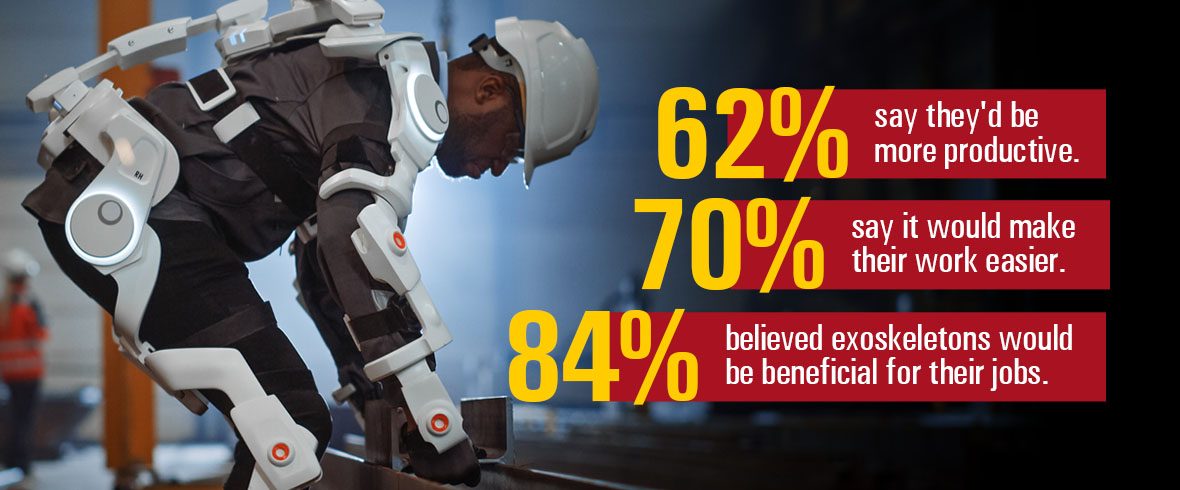
Construction exoskeletons offer various benefits for your workplace, from improved worker safety and productivity to increased well-being among your employees. One study found 84% of construction workers believed exoskeletons would be beneficial for their jobs, with 70% saying it would make their work easier and 62% saying they'd be more productive.
Here are some key advantages of using exoskeletons in your operations:
1. Injury and Strain Prevention
Exoskeletons can prevent strain and injury by supporting the body, back, shoulders and legs. Construction tasks typically involve heavy lifting, bending and prolonged physical stress. By assisting the body and offloading weight, exoskeletons can protect your workers and reduce the risk of common construction injuries like back sprains and shoulder injuries.
One study in an automotive assembly found a substantial decrease in neck, arm and back discomfort after three months of using an upper limb supporting exoskeleton.
2. Withstanding Repetitive Tasks
Construction exoskeletons can help construction workers with daunting tasks, making their workloads more bearable. For instance, the technology could reduce joint or back pain for workers who must keep their arms raised for hours, plastering a wall or installing drywall. With an exoskeleton, they can work longer hours without overexerting themselves. One study found that workers using a mechanical exosuit had lower perceived exertion than those who did not use the device.
3. Increased Productivity
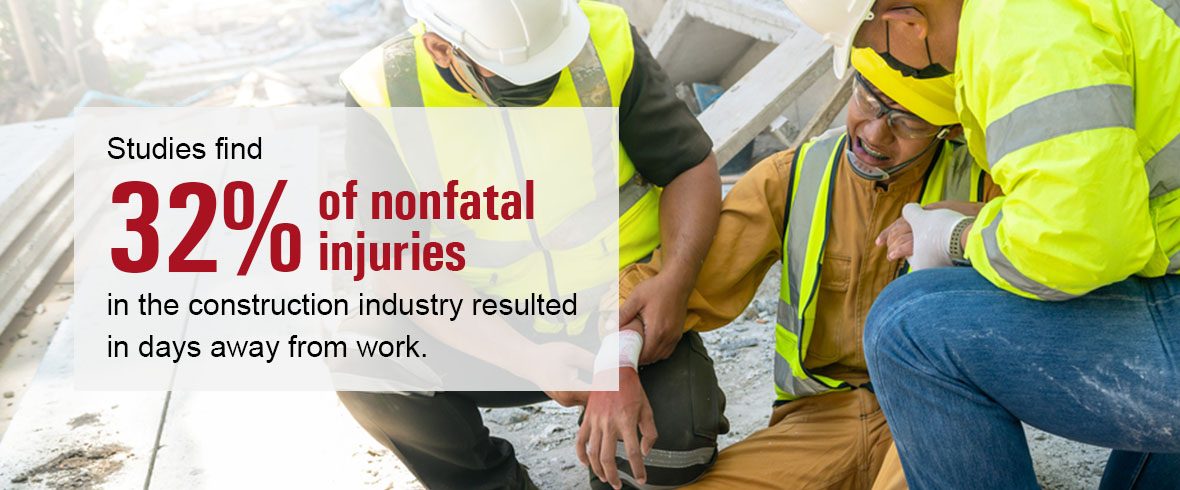
Studies find 32% of nonfatal injuries in the construction industry resulted in days away from work. Musculoskeletal disorders accounted for 55.4% of emergency room visits in 2019. Exoskeletons can benefit your operations by helping to prevent these injuries. Additionally, by reducing the energy exerted on repetitive tasks, exosuits can increase your workers' endurance.
Since the frame takes on a share of the load, it can reduce strain on workers' muscles and fatigue. Coupled with fewer injuries and muscle stress, the technology becomes an excellent productivity enhancer for your workers as they can work longer and more efficiently.
4. Improved Work Accuracy
Construction exoskeletons can improve your workers' accuracy by enhancing stability and reducing fatigue. Since they assist with physically demanding tasks, your employees can maintain better control and precision in their movements. One study found that construction workers could complete tasks with better focus and accuracy due to improved stability and less strain, resulting in enhanced performance and better-quality work. Overall, exosuits can contribute to a more precise and efficient construction process.
5. Adaptability to Different Tasks and Environments
Construction exoskeletons are adaptable to fit any construction task or work environment. You can customize and adjust them for different body sizes and job requirements. This adaptability ensures your workers can get the proper support and assistance, regardless of their task or workspace.
6. Improved Ergonomics
Exosuits can also promote better posture and ergonomics. They support and maintain proper body alignment, reducing strain on the back, shoulders and other areas. Overall, the technology can help workers maintain a neutral posture during tasks like heavy lifting. Improved posture can reduce the risk of strain injuries and long-term health conditions, improving your team's health and reducing absenteeism. One study observed the benefits of exoskeletons for lifting and stooping, finding 35-38% lower back muscle activity and discomfort for participants.
7. Enhanced Worker Comfort
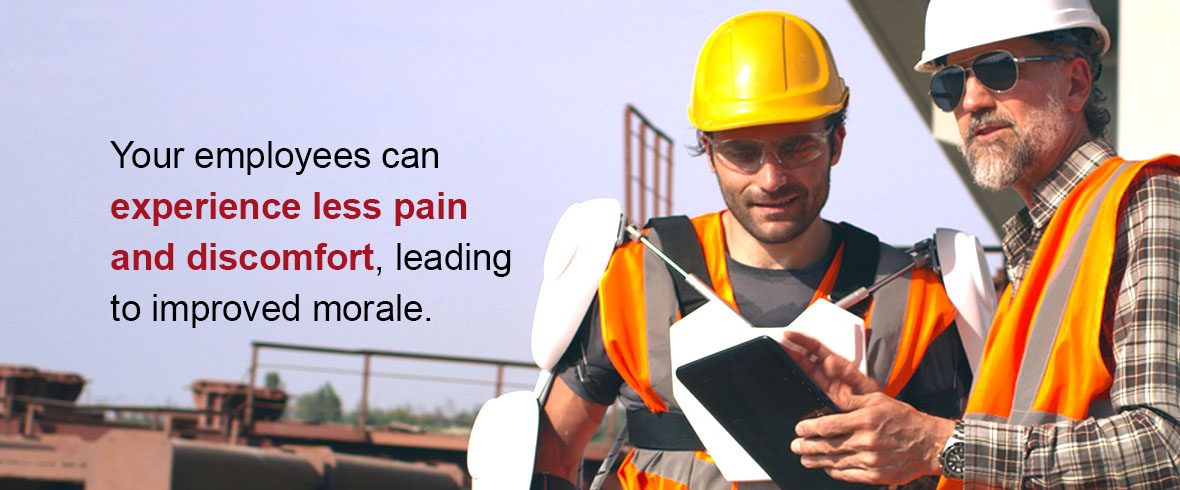
Construction exoskeletons can enhance worker comfort and well-being by reducing physical strain and fatigue. Your employees can experience less pain and discomfort, leading to improved morale. This technology can ensure a comfortable fit and allow plenty of freedom of movement, helping workers perform tasks without discomfort. Overall, enhanced comfort can positively impact well-being, engagement and job satisfaction.
8. More Opportunities for Older Contractors
Due to the labor-intensive nature of construction work, older contractors are more likely to be limited by their physical abilities. However, with a construction exoskeleton, they can handle more demanding jobs effectively. These devices can support the body, reduce strain and enhance strength, allowing older adults to perform tasks more efficiently and comfortably.
Ultimately, exoskeletons can allow older construction workers to remain in the industry, contribute their expertise and extend their careers. These devices can promote inclusivity, diversity and crucial knowledge transfer within the construction workforce.
Rent Quality Construction Equipment at The Cat® Rental Store
Construction exoskeletons show promise in improving your operation's efficiency and productivity. You'll find technologically advanced equipment at competitive prices through The Cat® Rental Store, regardless of your industry or applications. Our dealers offer extensive product knowledge and industry expertise and can help you make an informed decision to choose the right equipment for your applications.
To get started, browse our rental equipment selection today. Contact your local dealer about finding the right solution for your operations.
